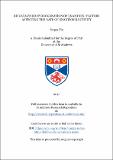Files in this item
Rh catalysed hydrogenation of enamines : factors affecting the rate and enantioselectivity
Item metadata
| dc.contributor.advisor | Clarke, Matt | |
| dc.contributor.author | Tin, Sergey | |
| dc.coverage.spatial | vii, 153 p. | en_US |
| dc.date.accessioned | 2017-04-10T09:44:27Z | |
| dc.date.available | 2017-04-10T09:44:27Z | |
| dc.date.issued | 2017 | |
| dc.identifier.uri | https://hdl.handle.net/10023/10599 | |
| dc.description.abstract | The main goal of this work was to understand factors affecting the rate of catalytic enamine hydrogenation, define promising chiral ligand scaffolds to perform the reaction enantioselectively, to prepare new efficient catalysts and to understand the reaction mechanism. Enamines were prepared by three different routes, one of which is a regio-selective intramolecular hydroaminovinylation of an amine-functionalised alkene. Achiral phosphorous ligands were tested in hydrogenation of these enamines. It was shown that electron-withdrawing ligands are beneficial in the reaction. Steric bulk within the ligands or the substrates also results in higher productivity. Electron-deficient phosphine ligands were able to perform hydrogenation of enamines with tetrasubstituted double bonds, which, to the best of our knowledge, have never been described in the literature. An unprecedented TON of up to 4550 mol mol-1 was achieved with one of the substrates. Hydrogenation of the enamines with chiral PHANEPHOS (in this project, 4,12-bis(di-aryl-phosphino-[2.2]-paracyclophane) ligands revealed that the electronic effect in the rhodium-catalysed hydrogenation of enamines is also of a paramount importance when chiral bis-phosphine ligands are used. The beneficial effect of iodine as co-catalyst is described. Addition of I2 improves both the rate of the reaction, as well as the ee of the product, exerting a dramatic effect in boosting the latter. An electron-deficient PHANEPHOS / Rh catalyst in the presence of I2 is able to hydrogenate even enamines with tetrasubstituted double bond. Chiral phospholane complexes of rhodium (complexes of chiral BPE (bis-(phospholanyl)ethane) (e.g. (+)-{1,2-Bis[(2R,5R)-2,5-diethylphospholan-1-yl]ethane}(cycloocta-1,5-diene)rhodium(I) tetrafluoroborate) and DuPhos (bis-(phospholanyl)benzene) (e.g (-)-{1,2-Bis[(2S,5S)-2,5-diethylphospholan-1-yl]benzene(cycloocta-1,5-diene)rhodium(I) tetra-fluoroborate) were also explored in this study. The use of an iodine co-catalyst proved to be very useful with the Rh / phospholane catalysts as well: addition of it resulted not only in the improvement of the rate of the reaction and increase in the enantioselectivity, but also caused the inversion of the absolute configuration of the product. An especially dramatic enantioselectivity switch was observed when chlorobenzene was used as a solvent. Mechanistic studies revealed that the enamine hydrogenation in the presence of a phospholane / Rh catalyst and iodine proceeds via the formation of the iminium ion, followed by the reduction of it with metal hydride. The actual catalyst is proposed to be a fairly acidic [Rh(ligand*)I2(H2)]+ complex. | en |
| dc.language.iso | en | en_US |
| dc.publisher | University of St Andrews | |
| dc.subject | Hydrogenation | en_US |
| dc.subject | Rhodium | en_US |
| dc.subject | Rh | en_US |
| dc.subject | Enamine | en_US |
| dc.subject | Catalyst | en_US |
| dc.subject | Enantioselective | en_US |
| dc.subject | Iodine | en_US |
| dc.subject | Phospholane | en_US |
| dc.subject.lcc | QD305.A8T5 | |
| dc.subject.lcsh | Enamines | en |
| dc.subject.lcsh | Hydrogenation | en |
| dc.title | Rh catalysed hydrogenation of enamines : factors affecting the rate and enantioselectivity | en_US |
| dc.type | Thesis | en_US |
| dc.contributor.sponsor | Dr Reddy's Laboratories | en_US |
| dc.contributor.sponsor | University of St Andrews. School of Chemistry | en_US |
| dc.type.qualificationlevel | Doctoral | en_US |
| dc.type.qualificationname | PhD Doctor of Philosophy | en_US |
| dc.publisher.institution | The University of St Andrews | en_US |
| dc.identifier.doi | https://doi.org/10.17630/10023-10599 |
This item appears in the following Collection(s)
Items in the St Andrews Research Repository are protected by copyright, with all rights reserved, unless otherwise indicated.

